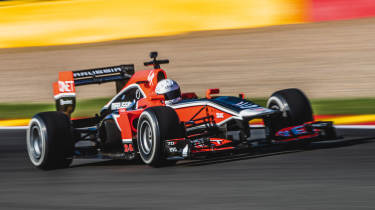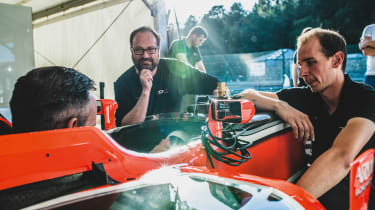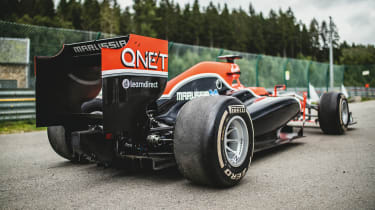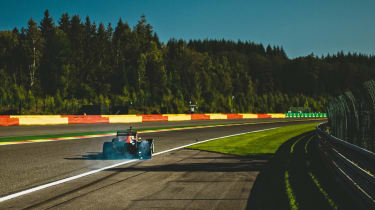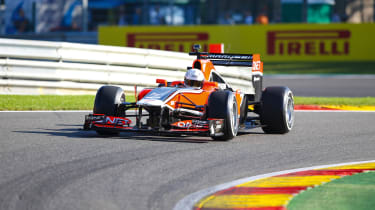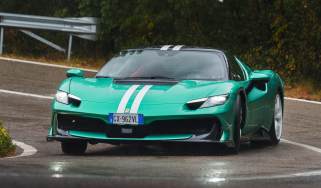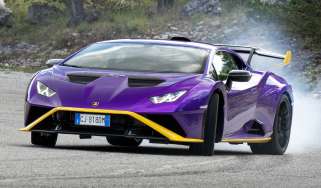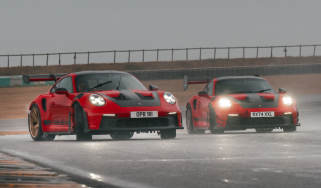Driving an F1 car at Spa-Francorchamps
Nothing can fully prepare you for the challenge of driving a Formula 1 car, as evo’s Adam Towler finds out – at Spa-Francorchamps, on race weekend
'Why don’t you drive it at Spa?’ SKREECH! Needle jars against vinyl; my world lurches to a halt on its axis. ‘We’re supporting Formula One Management,’ adds Tour de Force’s boss Matt Faulks, ‘putting on demo laps on the Saturday after qualifying. How cool would that be – your first drive of an F1 car and it’s at Spa, in front of the F1 paddock!’ I stare at Faulks in silence for an embarrassingly long period, expecting any moment to hear the words, ‘Nah, only joking.’ But they never come.
Earlier today I’d felt as green as Henri Pescarolo’s crash helmet as the pitlane exit at Snetterton turned into a boating lake and rain curtailed any running. In fact I’d secretly been thrilled when Faulks finally threw in the towel. Now relief has been replaced by a mixture of terror and hyper-elation. Spa. F1 car. Quali-day crowds. This is ridiculous; I’ve never even driven a single-seater before…
It’s only a few days later that I’m sitting snug within the impossibly tight confines of the 2011 Marussia Virgin Racing MVR-02, chassis 001, once the mount of Messrs Glock and D’Ambrosio, as a bag of expanding foam hardens around my spine to form my new ‘seat’. ‘Stig’, my newly assigned number one mechanic, is diligently checking the clearances down in the footbox, while the heat as the congealing foam cures makes me feel like I’ve just wet myself. But this isn’t just an MVR-02, it’s also a ‘TDF1’ – a specific re-engineering for a new purpose.
> Porsche 911 RSR v GT3 R v GT3 Cup - track-only 911s driven
When we visited TDF’s Bedfordshire HQ back in evo 254, we were amazed by this small but fascinating company that specialises in the recommissioning, running and development of modern-classic and contemporary F1 cars, and the car I alluded to in the final paragraph of that piece was our first sight of the TDF1 project. This 2011 MVR‑02 is the first of three Marussia Virgin Racing chassis the team will convert, followed by two C31 Saubers from the same year.
‘One of the key bits of feedback we had from our customers – the guys running original-spec F1 cars – was not just about costs, but about availability,’ Faulks tells me. ‘Take the Minardi [M198 – Cosworth V10 from 1998] we own. After every run it goes through a re-prep process, and it has to do that because of the heat cycles and various factors, not just engine and gearbox but safety-critical items as well. It’s very difficult with original-spec ’90s/noughties F1 cars to learn them, and develop as a driver – almost impossible because running them for more than 200 to 300km a year is very, very difficult and the costs very large.’
It’s not just post-run maintenance that boggles the mind; it takes three-and-a-half hours to merely attempt a start on the Minardi, for example, during which you need to slowly heat all its fluids, grapple with very high-pressure air and hydraulic systems that can cut a person in two if there’s so much as a pinhole somewhere, and constantly fiddle with an ancient laptop to convince the car’s systems that all is within parameters for an engine start. TDF is entirely capable of doing this, but it doesn’t come cheap, and as an owner, using the car has to be carefully planned in advance and supported by enough personnel. One day of fun could cost you tens of thousands of pounds.
The team’s response is the TDF1. The front wing, tub and crash structure are the same as the MVR-02’s, as is the floor, engine cover – all external surfaces in fact, including the rear wing (and working DRS). ‘We have removed some of the short-lifed components that were pared down for weight,’ says Faulks. ‘For example, we don’t run a carbon-composite steering column, but a conventional steel one instead, manufactured specifically for this car and which fits exactly the same and has the same crash-load paths. In doing so, we’ve removed an item that’s extremely expensive to service, make repairs on, and has a very short life. There are various things like that where we’ve sacrificed 500g, 750g, maybe a kilo [the car is just 30kg heavier overall], but in return you take a single-use component on a very tight inspection schedule and put in place something that’s over-engineered so it becomes a yearly inspection item. This car only needs a single re-prep each year or 3000km [an entirely achievable mileage], and an owner can start it in ten minutes without any outside assistance.’
TDF has working relationships with many current F1 OEMs, so, for example, the TDF1 runs on current Pirelli demo slicks and wets, and the wheels are the result of a unique collaboration with OZ Racing, and while fractionally heavier, no longer need to be regularly thrown in the skip. The suspension is also bespoke by Öhlins, but is now adjustable, so you don’t need an engineer in a truck with a shelf-load of dampers every time you want to make a minor adjustment. The brakes are still proper Hitco carbon-carbon jobs, but have a lower operating temperature window, making them at least a little more friendly and also putting less heat stress on wheel bearings and such like.
Where there is a big change is with the powertrain. The original 2.4-litre Cosworth CA engine just wasn’t going to be a practical solution given the TDF1’s remit, so Faulks and the team went back to basics, and considered what they – and most of the current F1 grid if they had the option – would go for as an ideal engine solution. The answer was a high-boost four-cylinder motor: tiny, light, low, great as a stressed member, and capable of lots of power. They settled on the Mountune 1.7-litre turbo four used in the F2 Championship from 2009 to 2012. A joint development programme was begun, with only the block and throttle body retained, and the result is a maximum of 600bhp, with a crankshaft centre line as near as makes no difference to the original Cosworth’s, the small matter of over twice the peak torque and a powerband three times as wide. A new carbonfibre-skinned magnesium gearbox casing helps retain the rigidity of the chassis, equalling that of a current F1 car and ensuring literally perfect corner weighting, suspension kinematics and weight distribution. It may be 90bhp down on the original, but crucially it drives just like the original car, like a proper F1 car should, and with a hell of a lot more grunt (450lb ft versus 210lb ft) on the corner’s exit, too. The ’box is now pneumatically operated, and has six gears, not seven.
TDF1 buyers get up to 21 days of simulator time and driver training, plus human performance coaching, but I have ten days before Spa, so it’ll be two trips to ‘the sim’ at Cranfield Simulation, a shakedown at our beloved Bedford Autodrome and, for all the use it does, one rather pathetic training jog around the village. The sim informs me the last of those is going to be woefully inadequate: thanks to its innovative combination of G-impersonating airbags and artificial movement, just 15 minutes within the tub has my T-shirt wringing wet with sweat like no gym session ever has. I’ll brush over the Bedford test too in the interests of brevity, but after two laps I realise I’m concentrating so hard and bracing my body against the forces with such determination that I’m forgetting to breathe. After four laps I can no longer support my head around the fast right-hander opposite the West pits, and after 15 minutes I have to lie on the floor when I get out of the car. It is as physically draining as it is thrilling, which is to say, immensely.
Then, impossibly soon, I’m at Spa, and a last-minute change by FOM means we (that’s me and just one other car – the Minardi M198) will be running as the first thing on track at 9.30am on Saturday. I’m up at five, driving to the circuit in the dark, and for the first time in my life the cinnamon bun I’d squirreled away holds no appeal whatsoever. My stomach is a reef knot of tension, and my general anxiety isn’t helped by the throngs of spectators already queuing at the turnstiles. It’s a weird feeling: half of me wants to run as fast as possible in the direction of Brussels, the other is excited to do the most amazing and privileged thing imaginable, the split a perfect 50:50.
But as soon as I get in the car there’s that feeling again: already it feels like home. I can’t move any limb more than a few millimetres, and Stig tightens the belts so hard I think my nuts are above my belly button, but I feel safe and confident, and dropping the visor mercifully completes that wonderful sense of isolation from the outside world. Unfortunately, there’s a delay, so I sit in silence, slowly brewing up inside like three bags left in a teapot overnight.
Finally, Stig gives me a last thumbs up, the engine is fired (wow – it’s loud without silencers!) and I’m pushed out from our area opposite the medical centre at Stavelot and onto the circuit. Moving away is the first challenge. It’s a hand clutch, operated via a paddle below those for the gearchange on either side, and every last millimetre of travel makes a difference. Slowly, slowly does it. Don’t stall it. As the front wheels begin to rotate, so I introduce the roaring, raucous four-pot, gently feeding in the power but being careful not to release the last few millimetres of travel prematurely. It works; we’re smoothly underway.
The tyres and brakes are completely cold, and it’s part of my job to bring them in gradually but not too hesitantly, while being aware that the brakes in particular heat up at slightly different temperatures, causing the car to snap to one side until they’re all online. Suddenly, as I approach the first left kink before Blanchiment, the revs soar with a yelp and the car stutters momentarily. It feels like it’s jumped out of gear, and as I frantically look down, the steering wheel flashes up dire warnings. As I approach La Source hairpin it happens again, and then again on the run down to Eau Rouge. It takes every last bit of my resolve not to panic, to ignore the thousands of people doubtless staring at me wondering why I’m tooling around like an idiot. I must get it back to the guys.
No sooner have I stopped on the apron than Stiggy has sprinted to my side, Faulks not far behind. Over the unsilenced thrash of the engine I can hear Faulks yelling something about the clutch, and motioning to get going again. Only later, with the benefit of the data, will we learn the cause: that by just one, maybe two millimetres, my left knee has brushed the clutch paddle – a price for being unnaturally tall for driving an F1 car, or perhaps due to debuting smaller boots, albeit ones with a slightly thicker heel, or maybe because the paddle has been recalibrated over the full sweep of its arc. It’s something I’ll ponder forever – a driver’s excuses – but it confuses the electronics, triggering the gearbox ECU into a fail-safe mode. But there are more immediate issues. The clutch is hot and now snaps like a piranha. Even though I get up to about 10mph, the engine eventually dies with a sudden lurch that slams my chin onto my chest. Shit!
This is all going badly wrong. Suddenly I feel the whole weight of this entire exercise on my shoulders. All the money spent to get to this point, the expectation of the magazine, the presence of the crowd, the paddock. Anger suddenly rises from nowhere and turns so white-hot it makes my ears sting. It’s time to get a grip. Almost subconsciously I hear Faulks scream something about ‘giving it the lot’, and I know it’s now the only option. It’s a bit like crossing the streams in Ghostbusters: Stig had warned me that the racing start is high risk; you’ve got to get it exactly right otherwise you’ll stall so badly it’ll physically hurt. Whatever. Revs, pop the paddle, bang. For a moment nothing seems to happen, and then I glance into the slender mirrors and see smoke – lots of smoke, and I know that it’s a peach, and the TDF1 slams forward on a quarter of a turn of opposite lock, simultaneously flushing out every last droplet of stress and apprehension. From here on in every millisecond is magic.
One lap to let the brakes and tyres come up to temperature. One more to get comfortable, get my eye in. Then lap four: it’s time. Over the start-finish line and focus on the boards before La Source, then hit the left-hand pedal. I hit it hard, but not quite 50bar, and I should be doing 70 with my left leg. I could manage it in the sim, but I haven’t built that confidence – not yet. I let the car roll in cleanly, trailing off the brake and nibbling the kerbing at what feels like walking pace. As the apex wall exits my sight line to the right, so the magnificent and terrifying vista down to Eau Rouge presents itself in the morning sunlight, arguably the finest sight in racing, and I prod the boost button on the wheel once we’re straight. I’ve no idea where the downhill run disappears to, because the distance is consumed in one furious stream of revs and vibration. I think I’m in fifth, and I lift the throttle gently. ‘Beware of it bottoming out – take it steady initially.’ Stiggy’s words come back to me. Peel away from the wall, turn in… now.
Up! I try to keep focused on the horizon point, but instead find myself staring directly into a patch of asphalt in front of me. The Gs are bewildering, and I fight with my neck and eyeballs to look further up, but then it’s already all over, we’re cresting the rise at Raidillon, and onto the Kemmel straight, and I notice the denseness of the crowd in the forest on the left, the kaleidoscopic blur of F1 team ‘merch’.
Now the speed is really building and I click the ’box into top. That’s fast. Oh man, that’s fast! (Later I learn it’s actually 183mph.) My helmet is wrenched around in the slipstream, and the vibration and blast force make it so hard to focus on that all-important braking point at Les Combes. I think I can see it. I know I can brake at the start of the kerbing on the left, as mad as that sounds. Improbably, I know I can brake even halfway along that kerb. But this lap I’ll go for the pedal between the board and the kerbing, then maybe adjust for the next lap. I hit the pedal hard and the Marussia slows with the kind of force that compresses all the air from my lungs – not surprising given it’s 2.5 G.
Through Malmedy with just a lift and down to Rivage, I’m a bit conservative but the line is good, and then a quick blast of throttle and a short-shift into third before a dab of brakes and into No-Name corner, which seems to have suffered a recent air strike by a B52, because there’s what feels like a giant crater in the middle of it. The TDF1 bucks, and it needs an application of lock, which I know sounds like Biggles has suddenly come to tea, but honestly, that’s the surprising, wonderful revelation about an F1 car: it’s so pure, so unfiltered in its communication, such an extension of your own body, that to do such a thing when required is just instinctive. And it feels outrageously good.
Full beans down to Pouhon. This is going to be serious. Fifth gear, small lift, turn in (3 G lateral), steady the throttle, heave the steering, lean into the forces – and they hurt – grinning like a madman, bleed in with the throttle. Oh yes! Take some kerb on the exit. This is much more like it. Through the right-left of Les Fagnes – a bit conservative, Adam, must be more aggressive next lap – then another short blast into Campus, and up into fourth gear and a steady throttle at Stavelot, past the boys – let this look respectable, please – and hard on the gas, speed multiplying frantically again.
I know Blanchiment is flat. I took it flat lap after lap on the sim. But it’s one thing to do that in a virtual world, quite another now, feeling the little wheel writhe incessantly in your hands, the crosswinds grabbing hold of the car and shaking it all-of-a-piece sideways, instantly sending my heart rate into the rev limiter. I’m in sixth, and I just blend out of the throttle a bit, then commit. The data will show a 180mph approach, and a 3 G lateral force. It feels otherworldly. Obscene. And then the big stop for the Bus Stop, again, a little on the conservative side, but that’s OK, it’s decent, and there’s the next lap to trim it further still.
Except there isn’t. That late start has meant the session has been cut short. There won’t be eight-or-so fast laps, just four. The row of red lights on the gantry catch my eye and a mixture of elation, relief and cheekiness compels me to wave to the crowd on the in-lap; some of the marshals even wave enthusiastically back.
Spa has been my Everest, pushing me to my physical and emotional limits, way beyond the mere act of driving a car fast, and in return has bestowed upon me a vivid, Technicolor driving experience so intense I can almost taste it. No hypercar will ever get anywhere near it. £1.5million plus taxes secures a TDF1 (and the chance to drive before a Grand Prix) – you know what to do if you have those readies available. But be warned: once you’ve experienced the purity and potency of such a machine, and the resulting speed and gravitational pull against your body, the sun rises and sets with it. It’s a drug. You’ll want it so, so bad. Forevermore.

